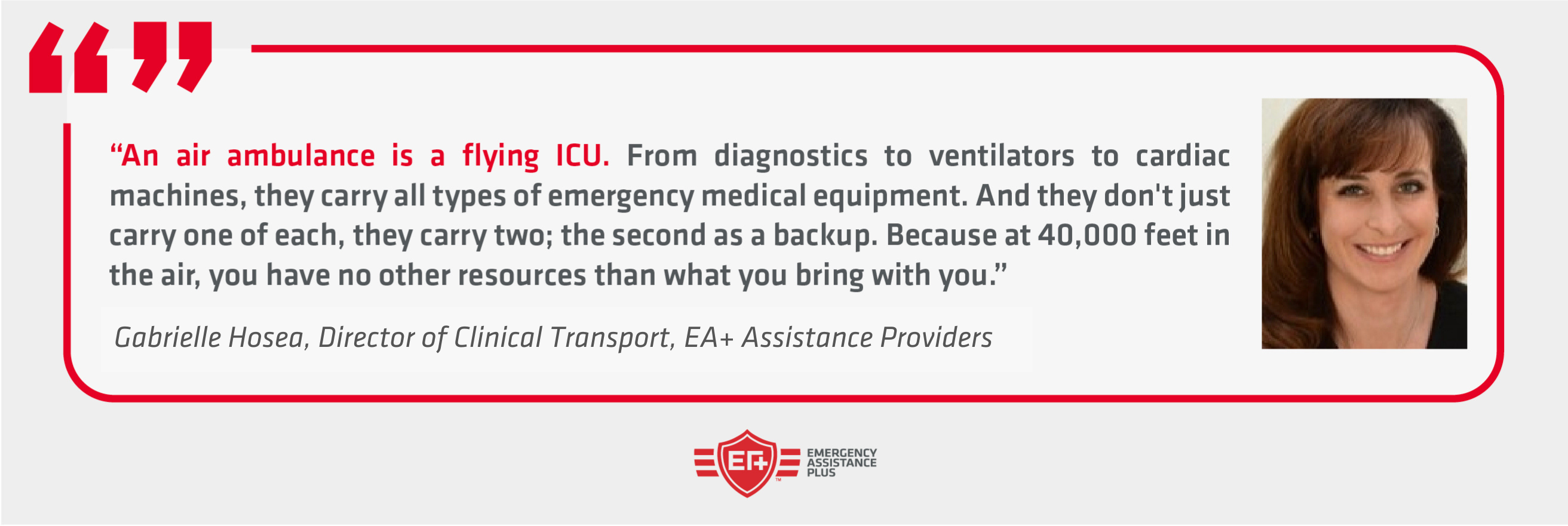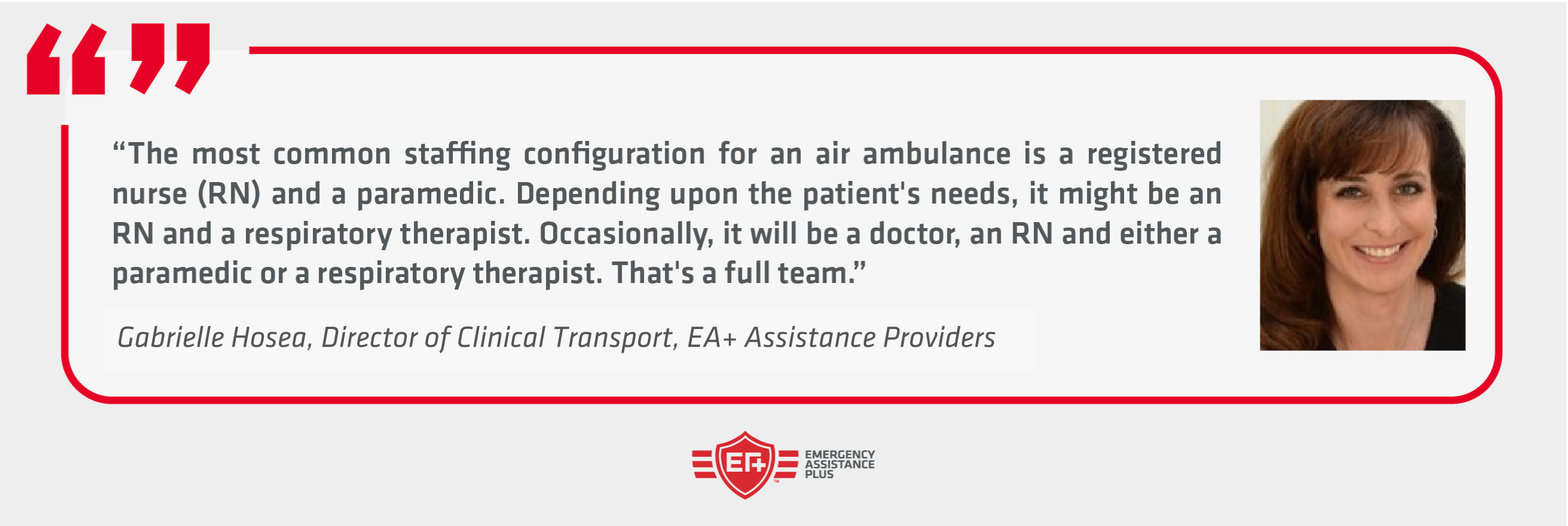Medical Evacuation
A deep dive into the fascinating world of air ambulances.
In the world of emergency medical services, air ambulances provide critical care in time-sensitive situations. Beyond their role as transport vehicles, these flying intensive care units (ICUs) showcase the convergence of medical innovation and operational efficiency.
This article covers the diverse types of air medical transport, distinguishing between domestic and international services, and sheds light on specialized flights for intensive care patients. Additionally, we delve into the financial landscape, offering insights into insurance coverage and life flight cost considerations, empowering readers to make informed decisions regarding air ambulance services.
Let’s get started!
An air ambulance is a critical emergency response vehicle that flies patients to medical care when traditional ambulances cannot reach them quickly enough, if the distance that needs to be covered is too great, or for other reasons. In this article, we will discuss “what is an air ambulance,” their rapid response times, advanced onboard care, and the scenarios necessitating their use.

An air ambulance is not merely a means of transport—it’s a flying intensive care unit (ICU). It’s about getting a patient to a medical facility quickly when hospitalization is needed, or when ground ambulance transport is not feasible.
The primary function of air ambulance services is to provide medical evacuation and swift transportation for patients to healthcare facilities, especially when hospitalization is needed or ground ambulance transport is not feasible.
Air ambulances offer a significant advantage in these time-critical situations, as they can quickly transport patients across vast distances, overcoming the obstacles of traffic and challenging terrains.
Air ambulances come in different shapes and sizes, each designed to serve a specific purpose.
Note: We will only be covering fixed-wing aircraft in this article, not helicopters, which are more often used for field rescue. “Field rescue” in the context of medical evacuation refers to the emergency retrieval and initial medical treatment of patients or casualties directly from the site of an incident, often in a combat or disaster area.
Generally, the term “air ambulance” refers to specially equipped fixed-wing aircrafts such as turboprop planes and jets, which are used for medium- and long-distance medical transport. The decision to use either turboprop planes or ambulance jets hinges on multiple factors, including the medical urgency, the patient’s specific health requirements, and the capabilities of the destination’s airport infrastructure.

An air ambulance is more than just a vehicle—it’s a fully equipped flying medical facility. Each flight is staffed with a team of medical professionals, which may include paramedics, nurses, and/or physicians, who work together to address various patient needs. These medical teams, trained for airborne medical emergencies, can deliver a higher level of care than typical ground ambulance staff, and manage complex clinical situations during flight.
The skilled medical professionals on board an air ambulance have undergone additional training and experience in flight physiology – i.e. how a patient’s medical needs may change when at altitude, granting them a broader scope of practice and more autonomy compared to other hospital care providers. This specialized training ensures that patients receive the best possible care during their journey to a medical facility.

Air ambulances, including air ambulance jets, are equipped with advanced life support equipment such as ventilators, ECMO machines, and monitoring units. This, coupled with the presence of highly trained medical professionals, ensures that patients receive ICU-level care during flight.
The medical equipment onboard can be customized to match the specific health requirements of the patient, ensuring tailored medical care during transport. The use of communication technologies such as satellite phones, UHF and VHF radios allow the crew to sustain communication with ground hospitals and transmit critical patient data in real-time.
The concept of air ambulances dates back to World War I, when they were used to transport injured soldiers from the battlefield to field hospitals. Over the years, these services have evolved and improved significantly, with technological advancements contributing to their efficiency and effectiveness.
Today, air ambulances have become a vital part of emergency medical services worldwide. They play a crucial role in saving lives, particularly in remote or hard-to-reach areas. The advancements in technology and capabilities over the years have not only improved the services provided but have also contributed to the growth and expansion of the industry.
Air ambulances have become an integral part of EMS air medical transport services across the globe. They play a pivotal role by providing rapid transport, which is vital for accessing timely care, especially during emergency situations.
In rural, mountainous, or disaster-affected regions, air ambulances enhance the accessibility of medical care where ground transport may be ineffective or unavailable. Moreover, air ambulance services employ telemetry technology to transmit patient vital signs to hospitals in real-time, enabling immediate preparation for the patient’s arrival and more efficient continuation of care.
Air and ground ambulances often work in tandem to offer the best possible care to patients. They coordinate to ensure smooth information exchange and seamless patient handover upon landing. Effective communication and coordination with ground emergency services are established through radio and telephone systems, as well as air-to-ground radios that provide updated patient reports directly to receiving emergency department nurses.
Ground transportation is sometimes used for transporting patients to and from the airport or a suitable helipad when air ambulances are used for hospital-to-hospital transfers. This synergy between air and ground services ensures that patients receive the most efficient care possible.
In medical emergencies, time is crucial and can make a life-or-death difference. The use of air ambulances in these situations is not just about transportation, but also about the level of care they can provide. The services employ telemetry technology to transmit patient vital signs to hospitals in real-time, enabling immediate preparation for the patient’s arrival and more efficient continuation of care.
As you might imagine, there are differences between domestic and international air medical services. Domestic air ambulance services are typically used for short to medium distances within the same country. However, when it comes to international medical repatriation, fixed-wing air ambulances, including aircraft like Learjet, Citation Bravo, and Bombardier Challenger, offer the necessary long-range capabilities and speed.
International air medical services face additional logistical complexities, requiring compliance with international aviation regulations and the need to coordinate across multiple jurisdictions. Moreover, the cost of international air ambulance flights typically ranges from $50,000 to $150,000 or more, which is significantly higher than domestic flights, partly due to additional costs like landing fees, handling fees, and international travel paperwork.
Certain medical situations require more than just a quick transport to a hospital. They require intensive care during a medical flight. This is where ICU medevac flights come in, providing specialized medical transportation of critically ill or injured patients who require continuous intensive care throughout the journey.
Aircraft used for ICU medevac are equipped with advanced medical devices and monitoring tools such as ventilators, cardiac monitors, and infusion pumps, and are staffed with a specialized medical team, including ICU doctors, nurses, and paramedics. These flights also require meticulous planning regarding the flight route and duration, as well as specialized post-surgery rehabilitation transport to cater to the recovering patients’ needs.
Air ambulance services, while lifesaving, are often associated with high costs. These costs are based on several factors including:
These costs can escalate with the need for specialized medical equipment, advanced life support systems, and highly skilled medical teams. However, many private health insurance plans offer some coverage for medically necessary air ambulance transport, though the extent of this coverage may vary.

Health insurance coverage for air ambulance services can be a complex topic, as it primarily determines coverage based on whether the service is deemed ‘medically necessary’ and the type of emergency transport required. Therefore, it’s essential for policyholders to review their health insurance plans and communicate with their providers to understand their specific coverage terms for air ambulance services.
Due to a significant portion of air ambulance flights being out-of-network, patients may face substantial out-of-pocket expenses, which stresses the need to understand potential costs and network limitations of their insurance plans.
It’s important to note that the cost of air ambulance services is not solely due to the flight itself. It encompasses a variety of expenses, including medical staff, aircraft operation, and advanced medical equipment. The inclusion of specialized medical personnel is one of the factors that contribute to the overall costs of air ambulance services.
Moreover, the requirement for specialized medical equipment on board can significantly increase the total cost of an air ambulance flight. However, while the costs may seem high, it’s essential to remember that these services provide life-saving medical care in the air, often in situations where time is of the essence.
Behind every air ambulance service, there’s a team of highly trained individuals working towards a single goal: to provide the highest level of care to patients in need. Air ambulance pilots are required to have a high level of experience and training, including:
Pilots must also possess specialized skills such as HEMS-specific flight hours, knowledge of their aircraft’s capabilities, and undergo extensive training covering diverse operational environments. Additionally, technological tools like the Flight Vector app and satellite communication systems, combined with GPS navigation, are integral for air ambulance teams in mission planning and patient data communication.
Safety is paramount in air ambulance operations. Flight team members often hold specialty certifications such as:
They are also trained in flight safety and aviation physiology, ensuring compliance with FAA standards.
From pilots to medical personnel, everyone follows stringent safety protocols and aviation medicine standards. For instance, pilots of air ambulance services are trained to meet the Commission on Accreditation of Medical Transport Services (CAMTS) standards to enhance operational awareness and safety.
Regular maintenance and inspections are crucial for ensuring the safety and reliability of air ambulance operations. They are essential for identifying and addressing any potential issues before they compromise the performance of the aircraft.
The expertise of the flight crew plays a significant role in the safe operation of air ambulance services. The pilots must be trained to operate in adverse weather conditions, as weather can be a critical factor in determining whether an aircraft can fly under visual flight rules.
Moreover, pilot training includes the specialization in coordination with local EMS agencies and hospitals, ensuring seamless patient care during air ambulance operations. Regular maintenance and inspections are crucial for upholding the safety and reliability of air ambulance operations. It is unsurprising that both aspects are equally important in this regard.
In conclusion, air ambulance services are a critical part of the emergency medical services ecosystem. They provide swift and efficient medical transportation in situations where time is of the essence. From their historical origins to the roles they play today, air ambulances have undoubtedly come a long way. With advancements in technology and medical equipment, they continue to improve and save lives. The remarkable stories of survival underscore the significant role they play in delivering quality patient care under challenging circumstances.
One of the primary services we offer to our membership at EA+ is medical evacuations, and this often includes air ambulances.
And if we could add one more practical piece of information to this explanation, it’s that you can’t really plan for when you need an air ambulance. It’s a situation that generally arises out of an emergency, and you may not have all your faculties to be able to process information and make decisions.
This is where we come in.
EA+ not only provides access to air ambulance services but also ensures support through all stages of medical emergencies. From navigating international medical systems to managing unexpected medical expenses, EA+ is dedicated to your safety and care.
Choosing EA+ means placing your trust in an organization committed to providing rapid, reliable, and compassionate care, ensuring that you and your loved ones receive the best possible outcome in challenging times.
Let EA+ be your partner in health and travel safety, because when it comes to emergencies, every second counts, and having expert support can make all the difference.
Visit our website to learn more about how we can help protect you during your most critical moments.
You would go in an air ambulance for certain medical emergencies where time is crucial or when appropriate medical care isn’t available at the patient’s current hospital and their medical condition requires ongoing medical care during transportation to a more appropriate facility. Air ambulances can swiftly transport patients to specialized medical facilities, such as trauma centers or stroke centers, for the necessary care.
Yes, the United States has air ambulances operated by hospitals, government agencies, and private companies to provide medical transportation and care.
Air ambulances are used for transporting individuals who are in serious accidents, stricken by serious illness, or need to be transported home from surgery at a distant hospital. They are primarily used in emergency and critical care situations.
Medical personnel on an air ambulance, such as paramedics, nurses, and physicians, provide advanced care and can handle complex clinical situations during flight, offering a higher level of care than ground ambulance staff.
Essential equipment includes ventilators for assisted breathing, ECMO machines for cardiac and respiratory support, and monitoring units to track vital signs continuously. Defibrillators are also on board to address cardiac arrhythmias, while infusion pumps administer medications and fluids intravenously. Portable ultrasound devices aid in diagnosis, while emergency medications and supplies ensure patient stabilization. Splinting devices and stretchers secure patients safely, alongside advanced life support equipment for managing critical emergencies. Additionally, communication equipment facilitates real-time transmission of patient data with ground medical facilities. Air ambulances generally carry two of everything.

Medical Evacuation

Medical Evacuation

Medical Evacuation

Medical Evacuation

Medical Evacuation

Medical Evacuation